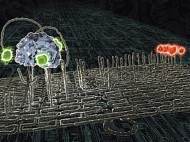Researchers made DNA molecules that behave as spider robots
 A team of scientists from Columbia University, Arizona State University, the University of Michigan, and the California Institute of Technology (Caltech) have programmed an autonomous molecular “robot” made out of DNA to start, move, turn, and stop while following a DNA track. The molecular robot, nicknamed “spider”, shows the potential for the development of molecular-scale reconfigurable robots
A team of scientists from Columbia University, Arizona State University, the University of Michigan, and the California Institute of Technology (Caltech) have programmed an autonomous molecular “robot” made out of DNA to start, move, turn, and stop while following a DNA track. The molecular robot, nicknamed “spider”, shows the potential for the development of molecular-scale reconfigurable robots
Milan N. Stojanovic, a faculty member in the Division of Experimental Therapeutics at Columbia University, led the project and teamed up with Erik Winfree, associate professor of computer science, computation and neural systems, and bioengineering at Caltech, Hao Yan, professor of chemistry and biochemistry at Arizona State University and an expert in DNA nanotechnology, and Nils G. Walter, professor of chemistry and director of the Single Molecule Analysis in Real-Time (SMART) Center at the University of Michigan in Ann Arbor, for what became a modern-day self-assembly of like-minded scientists with the complementary areas of expertise needed to tackle a tough problem.
“In normal robotics, the robot itself contains the knowledge about the commands, but with individual molecules, you can’t store that amount of information, so the idea instead is to store information on the commands on the outside,” said Walter. “And you do that,” said Stojanovic, “by imbuing the molecule’s environment with informational cues.”
DNA origami, an invention by Caltech Senior Research Associate Paul W. K. Rothemund, is a type of self-assembled structure made from DNA that can be programmed to form nearly limitless shapes and patterns. Exploiting the sequence-recognition properties of DNA base pairing, DNA origami are created from a long single strand of DNA and a mixture of different short synthetic DNA strands that bind to and “staple” the long DNA into the desired shape. The one they show in study was a rectangle that was 2 nanometers (nm) thick and roughly 100 nm on each side.
The researchers constructed a trail of molecular “bread crumbs” on the DNA origami track by stringing additional single-stranded DNA molecules, or oligonucleotides, off the ends of the staples. These represent the cues that tell the molecular robots what to do (start, walk, turn left, turn right, or stop).
To build the 4-nm-diameter molecular robot, the researchers started with a common protein called streptavidin, which has four symmetrically placed binding pockets for a chemical moiety called biotin. Each robot leg is a short biotin-labeled strand of DNA. Once its “start strand” leg was released, the spider’s enzymatic DNA legs reached forward to seek out the oligonucleotides.
Like a mouse following a trail of cheese crumbs, the spider would bind one of its legs to an oligonucleotide, dissociate from it, then be drawn forward by the next one. In this way, it walked a distance of 100 nanometers, or about 50 steps. Although that might not sound like much, previous “DNA walker” nanobots have only managed about three steps.
In the current system interactions are restricted to the walker and the environment. One of the next steps researchers plan is to add a second walker, so the walkers can communicate with each other directly and via the environment. Another goal of the researchers is to make the spider walk faster and how to make it more programmable, so it can follow many commands on the track and make more decisions, implementing logical behavior
Those advanced nanobots could be the basis for developing molecular-scale reconfigurable robots – complicated machines that are made of many simple units that can reorganize themselves into any shape. That ability would enable them to accomplish different tasks, or fix themselves if they break. For example, it may be possible to use the robots for medical applications to build a structure or repair damaged tissues.









Leave your response!